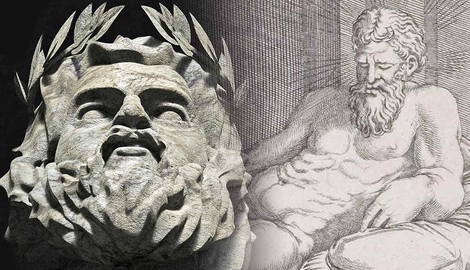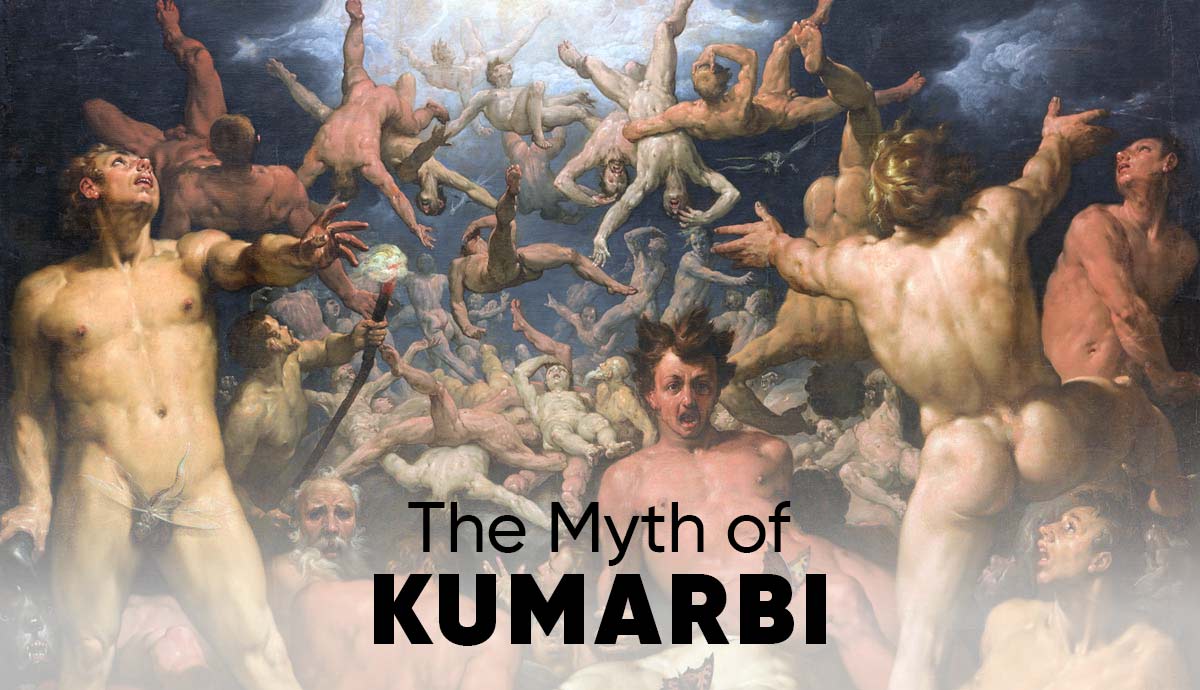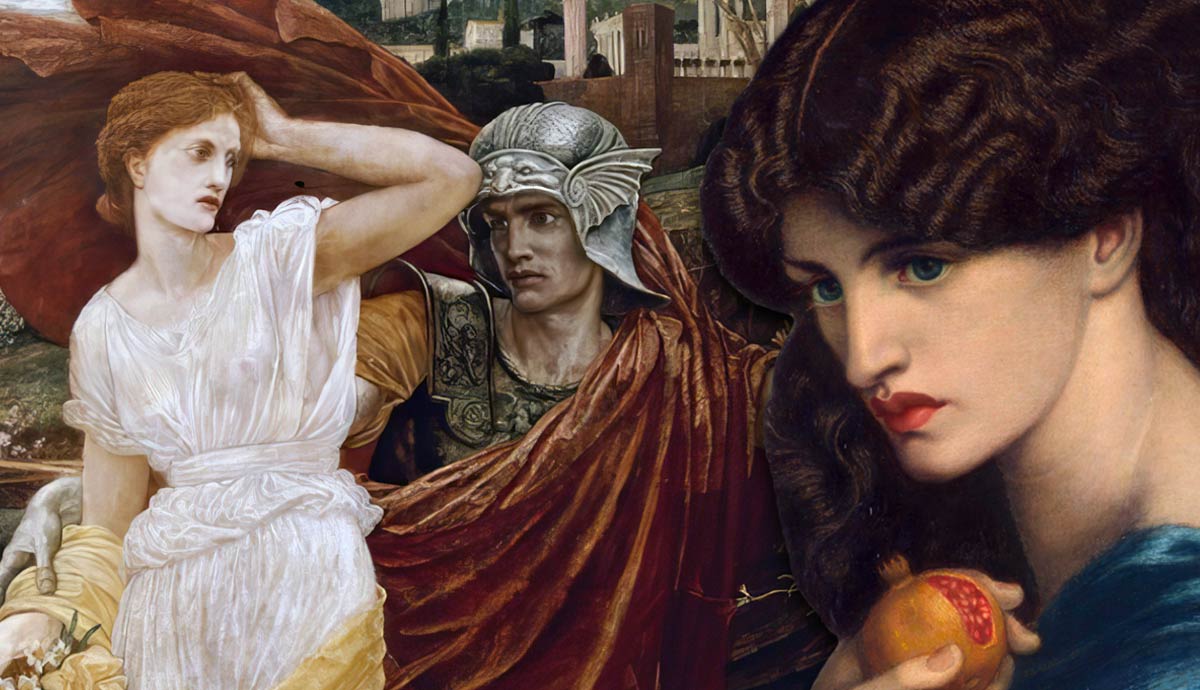
Zeus was the ruler of the Olympian gods and brother to Poseidon and Hades. Zeus was worshiped throughout the Greek world, the most important sites being at Athens, Acragas, and Olympia. At Olympia, the temple to Zeus contained a thirty-foot gold and marble statue of the god seated on a throne bearing the goddess of victory in one hand and a scepter in the other, on which was perched an eagle. The god was crowned in a wreath of olive shoots and adorned in gold robes and gold sandals.

Zeus is commonly represented as a sky god with power over the weather, but as the ruler of the cosmos he was also a god of order and justice. On a small scale, Zeus meted out justice to criminals, protected travelers and the home, or bestowed kings with the right to rule. On a larger scale, Zeus could guide the fates of nations. Homer’s Iliad opens with the lines:
“Sing, goddess, of the destructive wrath of Achilles, son of Peleus,
who laid countless pains upon the Achaeans,
and sent many strong souls of heroes to Hades,
making of them carrion for dogs and birds,
fulfilling the will of Zeus.”
By these words the epic opens, making it clear that all that is to come, including the subsequent fall of Troy, was part of Zeus’s plan. He was the guarantor of cosmic order, but also a means by which that order came about. His actions in the countless stories told of him describe how the world as the Greeks knew it and how it came to be as it was.
1. Birth and Rearing

Zeus was born the youngest of six children to the Titan gods Kronos (Cronus) and Rhea. While his other five siblings were swallowed by their father soon after their births, Zeus’ mother tricked Kronos into swallowing a swaddled stone instead of the newborn god. She then took him to Crete, where he was raised. Second-century CE writer Apollodorus recounts in his Library of Greek Mythology that the baby Zeus was given to the nymphs Adrasteia and Ida to rear while the Curetes, minor Cretan gods, banged their shields to prevent Kronos from hearing the child’s voice.
2. Titanomachy

When he was fully grown, Zeus rebelled against his father. Gaia convinced Kronos to regurgitate his swallowed children—though some versions state that the goddess Metis or Zeus himself gave Kronos a draught that made him vomit—and with their help, Zeus freed the Cyclopes from Tartaros (Tartarus), where they had been imprisoned. As thanks, the Cyclopes gave him the thunderbolt.
Zeus and the other Olympians would clash against the Titan gods for over ten years until they reached a stalemate. Zeus and his siblings then freed the Hecatoncheires (literally translated as hundred-handers), hundred-armed and fifty-headed monsters, and rallied them to his cause. They hurled hundreds of boulders at the Titans, and Zeus blazed into the center of the battlefield in a rain of thunderbolts. The battle shifted, and Zeus defeated his father, Kronos, imprisoning him and the other Titans in Tartaros (Hesiod, 7th c. BCE, pp.43-46).
3. Typhoeus

Following the Titanomachy came the Gigantomachy. Offspring of Gaia, the Giants were powerful beings that also challenged the Olympians but ultimately lost. At the end of the gigantomachy, Gaia gave birth to her last son, who was born by Tartaros, Typhoeus (Typhon). He was so fearsome that seventh-century poet Hesiod recounts in his Theogony:
“Surely that day a thing beyond all help
might have occurred: he might have come to rule
over the gods and mortal man, had not
the father of gods and men been quick to see
the danger […]”
Zeus leaped down from Olympus and smote the monster upon a jagged mountainside. With Typhoeus defeated, the Olympians proclaimed Zeus as the new king of the gods.
In Hesiod’s version of the story, Zeus divided up the spoils of the battle, handing out to each god their function and portion of the world as he pleased. In other versions, such as in Apollodorus’s The Library of Greek Mythology, Zeus and his brothers drew lots to determine which domain they would rule. Regardless of the version, Zeus was allotted the heavens, Poseidon the seas and all waters, and Hades the underworld.
4. Creation of Humans

According to Hesiod in his Works and Days, there were four separate and distinct races, or generations, of humans before modern humans.
The first was a golden race that lived during the time of the Titans. These humans lived like the gods themselves. They didn’t work and knew no hardship. They didn’t age, fall ill, or feel sorrow. For unexplained reasons, these humans were hidden under the earth, where they continued to live as spirits.
The second generation was of silver. These humans were fashioned by the Olympians and were unlike their golden precursors. The silver race remained children for a hundred years, and when they were finally fully grown, they lived only briefly. They injured each other and paid no respect to the gods. Zeus, in his anger, hid these humans underground as well.
Zeus himself made the next humans, these ones bronze. The bronze race was powerful and violent. They were great warriors but ultimately killed each other.
Zeus then created the fourth generation, which was more just and good than the bronze. A race of demi-gods and heroes. It is in this time that the stories of heroes like Achilles and Odysseus occur. This race, too, eventually died out, the last of which Zeus made immortal and gave them homes at the edge of the earth.
The king of the gods then created the fifth generation of humans, the race of iron. These are modern humans, whose lot is to, as Hesiod puts it, work unceasingly, then waste away and die. This race, too, Zeus will one day destroy.
5. The Birth of Athena

Zeus’ first wife was Metis, the goddess of wisdom, but their marriage did not last long. He was told by Gaia and Ouranos that she would give birth to a daughter who would be equal in intelligence to himself and then to a son who would become a king among gods and men. In order to avoid this fate, Zeus swallowed his wife while she was pregnant. By doing this, he was able to maintain his indisputable rule over the world.
A side-effect of eating Metis, however, was one of mythology’s strangest births. Zeus began suffering from a headache. With the help of Hephaestus, who opened Zeus’ head with his hammer, Athena—the goddess of wisdom and strategy—sprang out of Zeus’ head, fully dressed in her armor with her shield and spear.
6. The Wives of Zeus and the Birth of the Gods

Zeus had many wives. As mentioned previously, his first wife was Metis. His second wife was Themis, and with her has the Fates. His next wife was the daughter of Ocean, Eurynome. Together they had three daughters, the Graces, goddesses of beauty, joy, and all good things. Zeus then took his sister Demeter as his wife, and she gave birth to Persephone. Next he married Mnemosyne, who bore the nine Muses. Zeus’ sixth wife was Leto, and by her he had two more children, the twins Apollo and Artemis.
His seventh and most famous wife was Hera. Zeus would continue to spurn her throughout their marriage with numerous flagrant affairs. Their first quarrel occurred when Zeus gave birth from his skull to his daughter by Metis, Athena. In her anger and “without the act of love” Hera bore a son, Hephaistos (Hesiod, 7th c. BCE, pp.52-53).
7. Zeus’ Rule Challenged

In Book 1 of The Iliad, Homer names three Olympian gods that attempted to overthrow Zeus. Hera, Poseidon, and Athena chained and bound him, but Themis, the mother of Achilles, came to his rescue. She called upon Briareus, one of the Hundred-Handers that aided Zeus in his fight against Typhoeus, to go up to Olympus where he protected the chained god. Cowed by the giant, the three Olympians halted their plan and Zeus was freed from his bonds.
8. The Wanderings of Io

Io was a descendant of Argive royalty, and while sources differ on exactly who her parents were, they agree that Io was a priestess of Hera. Zeus seduced her in secret, and when his wife discovered the affair, he turned Io into a white cow, swearing to Hera that he never had relations with her. Hera didn’t believe him and demanded that he give her the cow, which she then imprisoned and set the monster Argos to guard.
Zeus instructed Hermes to free the metamorphosed Io from the monster, which he did by killing it, but Hera then sent a gadfly to continuously bite the tortured woman as she fled across the land. She first went to the Ionian Gulf, which came to bear her name. She eventually stopped in Egypt, where she was transformed back into her human form. There, she had a son, but Hera instructed the Curetes, the same gods that protected the infant Zeus from his father, to steal her son away. Zeus killed the Curetes, and Io wandered through Syria to find her abducted son. When she found him, she returned to Egypt where she lived out the rest of her days.
9. Europa

Europa was the daughter of a Phoenician king who caught the attention of Zeus. In order to seduce her, he ordered Hermes to drive the royal cattle down to the shore where the girl was known to play, and once there, Zeus disguised himself as a magnificent white bull. Europa was drawn to the beauty of the animal, not knowing that it was in fact the king of the gods. She hopped onto the bull’s back and Zeus carried her out with him into the sea, bringing her all the way to Crete. Zeus impregnated the girl, and she gave birth to Minos, later king of Crete.
10. Semele

Semele was a princess of Thebes and daughter of Cadmus, who was the brother of Europa. Zeus impregnated Semele, and when Hera discovered the affair, she vowed vengeance on the soon-to-be mother for the shame she had caused her. Hera disguised herself as an old crone and manipulated Semele into asking Zeus for a gift, specifically that he appear to her in his godly form as he does for Hera.
Semele went to Zeus and asked for an unspecified gift, to which Zeus agreed, swearing an unbreakable oath on the river Styx. When Semele told him what she wanted he was dismayed but had no choice but to oblige. He revealed his divine form and upon seeing it, Semele burst into flames. The child she carried was torn from her womb and sewn onto Zeus’s thigh where he was brought to term. Thus Dionysos (Dionysus), the twice-born, was born.
11. Lykaon

Like most gods of the Greek pantheon, Zeus was both loved and feared, and expected piety and devotion from humanity. To those that did not show the level of affection he was due, or to those that spurned him outright, Zeus punished them with a heavy hand.
Early in his reign, Zeus descended to earth and walked the lands until he came to Arcadia. Through signs and omens, he let the people know that a god was among them. Common people offered prayers, but the king, Lykaon, mocked their piety and sought to test Zeus to prove whether or not he was in fact a god. The first test was to try and murder Zeus in his sleep, but when this method failed Lykaon was still not satisfied. The king killed a hostage sent to him by the Molossians and cut him into pieces, then cooked him and served him to the disguised Zeus. Enraged, Zeus hurled a thunderbolt and brought down the king’s house. Lykaon fled into the fields, where Zeus turned him into a wolf.
References
Apollodorus. (1st or 2nd century CE). The Library of Greek Mythology (R. Hard, trans). Oxford University Press, 1997
Homer. (8th or 7th century BCE). The Iliad (R. Fagles, trans). Penguin Books USA Inc., 1990
Hesiod. (8th century BCE). Theogony and Works and Days (D. Wender, trans). Penguin Group, 1973
Ovid. (43 BCE-17 CE. or 18 CE). Metamorphoses (C.Martin, trans). W. W. Norton & Company, Inc., 2005










